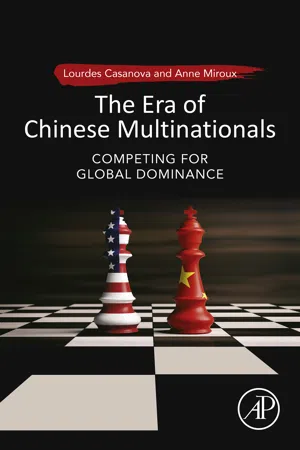1
Chinese firms take the helm
Abstract
Chinese multinationals have become de facto global leaders. In 2018, about 20% of the Fortune Global 500 firms were Chinese. China grew by leaps and bounds over a short period of time, mainly after the Global Financial Crisis (GFC). In just one decade, several new Chinese firms have become world leaders in their own industries. If we consider the five top leaders of eight industries, 40% of these firms are Chinese; there were none in 2004. This chapter also explores how Chinese firms must bridge development gaps in profitability, market capitalization, and geographic footprint compared to more established Western multinationals. European and American companies, for instance, dominate the list of the top 100 firms ranked by foreign assets (published by the UN). However, based on quantitative evidence, the chapter shows that Chinese companies’ global impact is larger than expected and will continue to grow.
Keywords
Chinese multinationals; Market capitalization; Profits; Emerging markets; China; Foreign direct investment; Outward foreign direct investment
In every crisis, there is opportunity.
Chinese proverb
Acronyms
eMNCs emerging market multinational companies
G-7 Group of 7: Canada, France, Germany, Italy, Japan, United States, and United Kingdom
GDP gross domestic product
GFC global financial crisis
GPM gross profit margins
E20 Emerging markets 20: Argentina, Brazil, Chile, China, Colombia, Egypt, India, Indonesia, Iran, Malaysia, Mexico, Nigeria, the Philippines, Poland, Republic of Korea, Russia, Saudi Arabia, South Africa, Thailand, and Turkey
M&As mergers and acquisitions
ROA return on investments
SGCC state grid corporation of China
SOE state-owned enterprises
In both scale and reach, Chinese companies have grown at an accelerated pace, particularly since the 2008 Global Financial Crisis (GFC). While China’s extraordinary rise on the global stage has garnered international publicity, the success of China’s companies has made significantly fewer headlines. Even as analysts recognize significant changes in the world economies in the decade since the crisis, Chinese firms have been comparatively less studied. On closer inspection, they are major players in banking, construction, and other sectors, as well as shapers of global industry (Backaler, 2014; Fishman, 2006; Guo & Gallo, 2017; Healy, 2018; Li-Hua, 2014).
In parallel with China’s overall economic growth, Chinese firms leveraged the opportunities triggered by the GFC to acquire global assets (see Chapter 2; Nie, Dowell, & Lu, 2012). The Chinese government also supported and encouraged the global expansion of Chinese multinationals (see Chapter 4). Drawing on databases including the Fortune Global 500 ranking, Standard & Poor’s Capital IQ, Financial Times fDi Markets, UNCTAD Statistics, the World Bank, and the Statistical Bulletin of China’s Outward Foreign Direct Investment published by China Statistics Press (MOFCOM—Ministry of Commerce of the People’s Republic of China), this book studies the ascent of Chinese firms to become some of the world’s largest companies (Casanova & Miroux, 2016, 2017, 2018).
While many Chinese firms gained scale in the large Chinese domestic market, they also pushed forward aggressively into many global markets (Pearce, 2011; Wang & Miao, 2016). According to MOFCOM (2017), 25,000 Chinese domestic enterprises had established more than 39,000 overseas enterprises in 189 countries with total assets of $6 trillion. Chinese firms that once competed on the basis of lower prices (see Chapter 8) are now positioning themselves as innovators rather than cost leaders and disrupting the competitive landscape (Tse, 2014). According to the Global Innovation Index (2018), China in 2018 ranked 17th in the world in innovation at par with countries such as Japan (ranked 13th), France (16th), and Canada (17th). In 2018, China also had the highest number of researchers, patents, and publications in the world, besting the United States.
Chinese firms quickly evolved to compete with visibly improved products and services, such as Huawei’s lead on 5G technology, thereby raising the bar for global competition. China’s embrace of technological innovation as a means of growth has increased global recognition for some Chinese firms such as Alibaba and Tencent (see Chapter 9). However, many other success stories have emerged below the radar of public and private sector leaders. One such example is State Grid Corporation of China (SGCC), the second-largest company in the world by revenue with a significant presence in more than 15 global markets. From producing innovative technology (ultrahigh voltage technology capable of reducing losses in transmission line) to the development of an international (and even intercontinental) grid, SGCC’s strategy for growth has potentially far reaching disruption (see case study in Chapter 6).
1.1 Chinese companies at the top of the Fortune Global 500 ranking
The Fortune Global 500, a long-established and broadly accepted ranking of global companies based on revenues, comprises companies from 36 countries, Hong Kong, and Taiwan. As of 2018, nearly half of the listed firms were from the United States and China, far more than from any other country. In the years since the GFC, China has increased its share of firms listed on the Fortune Global 500 from 16 in 2005 to 111 in 2018, second only to the United States with 126 firms. No other emerging economy has yet been able to mirror the rise of Chinese firms (see Fig. 1.1). The ascent of Chinese firms in the ranking is even more impressive if one adds the nine firms from Hong Kong to those from mainland China—bringing the 2018 total to 120 firms—...
